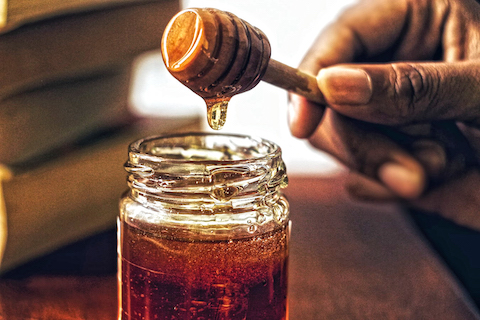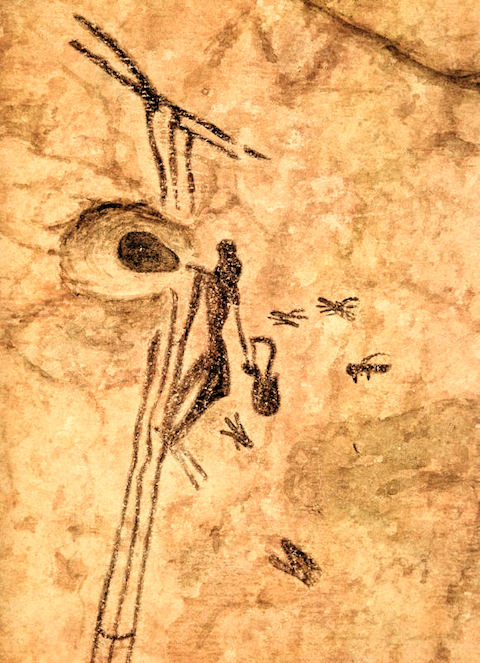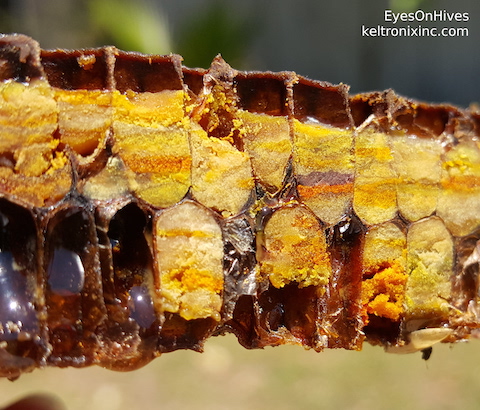
Honey is a miraculous substance, containing enzymes, vitamins, minerals, and antioxidants. But it’s not the only amazing thing bees make in the hive.
Honey starts as nectar that bees gather from thousands of flowers on foraging flights.
The bees store the nectar in a special sac next to the stomach. On returning to the hive, they transfer it to the mouths of waiting worker bees.
Workers ingest and regurgitate the nectar over and over for several minutes. Their digestive enzymes convert the sucrose in the nectar to other forms of sugar and add gluconic acid and hydrogen peroxide that act as preservatives.
Finally, they deposit the liquid in storage cells where other workers fan it with their wings to reduce its water content, till it takes on the thick consistency of honey.
Honey provides the carbohydrate energy that powers the colony. But the hive requires other products too.
Some bees gather water, which will be used for evaporative cooling. They’ll fan air across it to maintain a constant 93 degrees Fahrenheit within the hive.
Others gather pollen, which is mixed with honey to ferment and create “bee bread,” the hive’s main source of protein.
Still others gather tree resin, which they mix with wax and saliva to produce “bee glue,” or propolis. It’s used to mend the hive and line the brood area to keep it clean, since it has antibiotic qualities.
Background
Synopsis: Honeybees are the only insects that produce food that humans can consume directly, and it’s a good thing they do, because humans have never been able to duplicate the process required to make honey. As long as it’s sealed, honey will not spoil—not for millennia! It is an amazing food that even has special medicinal benefits.
- Honey provides energy for honeybees. It contains enzymes, vitamins, minerals, and antioxidants, but mainly it is composed of sugar carbohydrates (fructose, glucose, maltose, and sucrose).
- It takes the life’s work of 3 dozen bees to produce just one tablespoon (21 g) of honey, which has 64 Calories and 17 g of sugars.
- Most worker bees collect nectar from flowers for honey. Each day, an individual worker may visit up to 2,000 flowers, returning to the hive to unload her nectar to hive bees 20–40 times. She may fly more than 500 mi (800 km) in her lifetime.
- To produce a single pound of honey, workers fly the equivalent of the circumference of Earth, visiting about 2 million flowers.
- A typical hive needs to make 60 lbs (27 kg) of honey to survive the winter—that’s the life’s work of more than 46,200 bees. Lucky for us, most hives produce two or three times what they need each year.
- An individual worker bee may fly more than 500 mi (800 km) in her lifetime.
- Each day she will visit thousands of flowers, sucking their sweet nectar through her proboscis into her special nectar sac, which is called a proventriculus and is located between her stomach and her wings.
- She can carry about half her weight in nectar, but she must collect it from more than a thousand flowers, returning to the hive frequently to unload.
- The nectar she collects is sucrose and between 70 and 80% water. She adds enzymes from her saliva and proteins from glands in her mouth to begin breaking down the sugars.
- Once the proventriculus is full, she returns to the hive and transfers the nectar into the waiting mouths of hive bees, who continuously regurgitate and ingest the liquid back and forth for up to 20 minutes, forming bubbles to help decrease its water content.
- The hive bees ripen the honey by adding digestive enzymes that hydrolyze the sucrose into fructose, glucose, and maltose while producing minute amounts of hydrogen peroxide and gluconic acid.
- Once the fluid reaches 50–70% water content, the bees place it into storage cells in the hive, where a constant temperature of about 93°F (34°C) is maintained.
- The bees then fan the honey with their wings until its water content is reduced to about 18–20%, rendering it too saturated to ferment. At this point, the cells are capped with wax. As long as the honey is kept away from water, it will not spoil.
- Gluconic acid makes the honey very acidic with a pH of just 3.0–4.5, and hydrogen peroxide gives it antiseptic and antibacterial properties. Along with honey’s low water content, these properties create an environment that is hostile to microbes, protecting the honey from spoilage. But honey has even more amazing health benefits!
- Honey has been shown to suppress nighttime coughs better than some common over-the-counter cough medicines when a couple of teaspoons are taken before bedtime.
- Honey’s anti-inflammatory and antibacterial characteristics make it especially effective in healing burns and skin conditions. Today, commercial honey-based bandages are available to take advantage of these properties.
- As a replacement for sugar, the bioactive plant compounds and antioxidants in honey are believed to improve cardiovascular health by reducing triglycerides and “bad” LDL cholesterol while increasing “good” HDL cholesterol. Some studies suggest replacing sugar with honey may also help to reduce blood pressure.
- Some researchers suggest that the antioxidants in honey may improve brain function, decrease anxiety and depression, and even prevent some memory disorders.
- However, honey should never be given to infants under 12 months of age, because their immune systems aren’t acidic enough to protect against small amounts of C. botulinum bacteria sometimes found in honey. These bacteria can produce a toxin in the large intestine, resulting in botulism.
- Humans have enjoyed and have used honey as a remedy for millennia.
- Sumerian clay tablets from about 4,000–5,000 years ago refer to the medicinal usage of honey.
- In Egyptian tombs, archaeologists have found pots of unspoiled honey that are thousands of years old. Ancient Egyptians used honey both in ointments and as an infection barrier for wounds.

- Honey is not all that honeybees collect and turn into new products in the hive. Forager honeybees also collect water, pollen, and tree resin, which are used in the hive to produce bee bread, royal jelly, beeswax, and bee glue.
- Some bees collect water that is used for evaporative cooling and humidity control in the nest. Bees need water for digestion and to hydrate nurse bees so they can create royal jelly. They also use it to restore honey that has crystallized.
- Some workers collect pollen on pollen pikes on their hind legs. It is mixed with honey to create bee bread, the main source of amino acids for honeybees. To make bee bread, field bees deposit pollen into a cell, then hive bees pack it down with their heads, add a drop of honey, and seal the cell, where the pollen ferments. Bee bread is fed directly to worker larvae by nurse bees to nourish them and also inhibit development of their ovaries. Adult workers may also consume bee bread. In new hives, fresh pollen may be consumed if bee bread has not yet been created.
- Other foragers collect tree resin on the pikes on their hind legs and use it to produce propolis, or bee glue, by mixing beeswax, saliva, and tree resin. This mixture can be used to seal gaps in the hive. Propolis is known to inhibit fungal, viral, and bacterial growth, and is used to line the brood nest area of the hive to ensure a clean environment.
- The next EarthDate episodes will address the role honeybees play as the pollinators for about one-third of all our food crops… and the dangers they face from pests and pesticides, with some hopeful news about a new form of protection.


